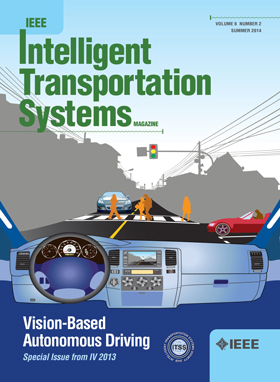Road Semantic-Enhanced Land Vehicle Integrated Navigation in GNSS Denied Environments
IF 7.9
1区 工程技术
Q1 ENGINEERING, CIVIL
IEEE Transactions on Intelligent Transportation Systems
Pub Date : 2024-09-05
DOI:10.1109/TITS.2024.3449892
引用次数: 0
Abstract
Continuous and highly accurate positioning of land vehicles continues to be a substantial challenge in urban GNSS-denied environments. Although the vehicle motion model (VMM) is fused to mitigate the positioning error, the problems of position error accumulation over a distance remain. Hence, we introduce an innovative multi-information integrated navigation approach that leverages visual semantics in conjunction with a lightweight high-definition (LHD) map for absolute position refinement. This method enhances the navigation solution by integrating a vehicle-mounted GNSS/INS system with the precise localization capabilities of road semantics, such as lane lines and poles, through camera vision. We establish a comprehensive road semantic measurement model in the pixel frame to directly use raw pixel data for a tightly coupled integration process. Additionally, we examine the distinct contributions of lane lines and poles to the estimation of navigation error states using a simplified measurement model. Field tests with land vehicles demonstrate the efficacy of our proposed method and show that the longitudinal and lateral positioning errors decrease to 0.43 meters and approximately 0.27 meters, which are significant enhancements due to road semantic cues.全球导航卫星系统被拒环境中的道路语义增强型陆地车辆综合导航
在没有gnss的城市环境中,陆地车辆的连续和高精度定位仍然是一项重大挑战。虽然融合了车辆运动模型(VMM)来减轻定位误差,但位置误差在一段距离内积累的问题仍然存在。因此,我们引入了一种创新的多信息集成导航方法,该方法将视觉语义与轻量级高清(LHD)地图结合起来进行绝对位置优化。该方法通过相机视觉将车载GNSS/INS系统与道路语义(如车道线和电线杆)的精确定位能力相结合,增强了导航解决方案。在像素帧内建立综合道路语义测量模型,直接使用原始像素数据进行紧密耦合集成。此外,我们使用一个简化的测量模型来研究车道线和极点对导航误差状态估计的不同贡献。陆地车辆的现场测试表明,该方法的有效性,并表明纵向和横向定位误差减小到0.43米和约0.27米,这是由于道路语义线索的显著增强。
本文章由计算机程序翻译,如有差异,请以英文原文为准。
求助全文
约1分钟内获得全文
求助全文
来源期刊

IEEE Transactions on Intelligent Transportation Systems
工程技术-工程:电子与电气
CiteScore
14.80
自引率
12.90%
发文量
1872
审稿时长
7.5 months
期刊介绍:
The theoretical, experimental and operational aspects of electrical and electronics engineering and information technologies as applied to Intelligent Transportation Systems (ITS). Intelligent Transportation Systems are defined as those systems utilizing synergistic technologies and systems engineering concepts to develop and improve transportation systems of all kinds. The scope of this interdisciplinary activity includes the promotion, consolidation and coordination of ITS technical activities among IEEE entities, and providing a focus for cooperative activities, both internally and externally.
 求助内容:
求助内容: 应助结果提醒方式:
应助结果提醒方式:


